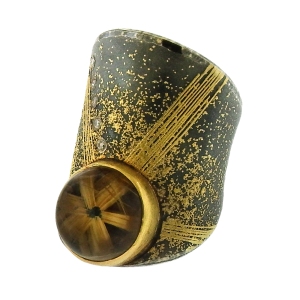
I’ve decided to do a series of posts on inclusions, as it is simply one of the most frequent topics that comes up with customers. Everyone knows the value of a nice, clean gemstone: no-one wants a diamond with a dirty great fracture, or a ruby with a big black crystal under the table. However, the search for a perfectly clean stone is a bit of a fool’s errand. The GIA no longer uses the term ‘internally flawless’ to describe diamonds as there is simply no such thing; with increasingly powerful microscopes, if you magnify anything enough times, you will find something. But above all, I think we need to reconsider attitudes to inclusions. The GIA doesn’t call them inclusions; preferring the term ‘clarity characteristics’, and if you believe that the very words we use are instrumental in influencing how people feel about a thing then we can see that this is a much less judgemental term to use. They describe clarity characteristics in a stone as ‘the eyewitnesses to its birth’. They can provide valuable information as to how and where it grew, indicate events in its history and sometimes on a broader scale, in the the events and internal turmoil of earth’s history. They can help detect whether a stone is natural or synthetic and provide evidence as to whether the stone has been treated or not. They almost always tell a story. And if you’ve ever held a pile of synthetic rubies in your hand you might find yourself thinking, as I have, that stones without inclusions can have all the appeal of a piece of coloured glass.
Inclusions are not always bad, either, and that’s my subject today. Sometimes they have a beneficial effect on a stone’s beauty, and that is certainly the case with needles! Needles are defined as long, thin, solid crystals or hollow tubes; if it’s hollow it might be filled with fluid or gas. A group of fine needles is called ‘silk’. Silk is what gives high quality sapphires their soft, velvety appearance, and can give rise to cat’s eyes and stars, if it is oriented along the stone’s crystal planes. Needles to me are at their best when they are present as visible needles in stones such as quartz and prehnite. These stones are desirable precisely because of their inclusions. In quartz, rutile needles can appear gold, copper, red and black. They can occur sparsely or in clumps; they can be thick and coarse, or they can be fine, the so-called angel-hair variety. You can also get rutilated prehnite; a soft, green bodycolour intersected with striking black needles. When we talk about inclusions it’s easy to see this as always having a negative connotation but it simply isn’t so. Rutilated stones really need only a simple, beautiful setting to show them off to their best, however, I love the setting below, where the design on the body of the ring echoes the spokes of the rutile in the quartz.




To shop our collection of rutilated stones, please click here. Next time I’ll be talking about the dreaded fractures!
joopygems.com



